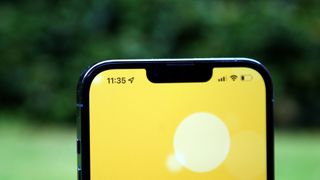The iPhone 13 Pro got a big camera upgrade – but users didn't like it
iPhone photography inspired by oil paintings, is it?

When Apple designed the new iPhone 13 camera app, it hoped to improve on past handsets by learning from oil painting techniques – but did it really make things better?
In an interview with Wallpaper* magazine, the Apple design team explained the interdisciplinary approach of their Cupertino studio – described once by designer Jony Ive as a place where “industrial designers sat next to a font designer, sat next to a sound designer, who is sat next to a motion graphics expert, who is sat next to a colour designer, who is sat next to somebody who is developing objects in soft materials.”
That cross-medium approach clearly informs even the processing techniques used in the iPhone camera app, too. Wallpaper* writes that “The iPhone 13’s camera represents a substantial upgrade, with Pro models getting a triple-lens system with a macro mode and 6x optical zoom [from 0.5x ultra-wide to 3x telephoto zoom].
"As UI designer Johnnie Manzari explains, the camera now has a new portraiture mode for photos and a cinematic mode for movies. Both exploit the emotional aesthetics of shifting depth perception.”
Manzari adds, “We did a lot of research into the history of portraiture as an art form and a craft, going back to oil painting and how they informed photographic traditions.
"The insights we got were about the importance of the focus on the eyes, the treatment of the background and lighting. These led to the features we’ve added to the iPhone over the years, which balance these timeless principles in a way that’s accessible and more intuitive.”
Alan Dye, VP of human interface design at Apple, adds that “It feels much more human and there’s more of a connection to it, even though it’s an artefact of analogue photography.”
Get daily insight, inspiration and deals in your inbox
Get the hottest deals available in your inbox plus news, reviews, opinion, analysis and more from the TechRadar team.
What's the problem?
The potential to capture a more analogue, old-timey feel for modern, digital photography is certainly intriguing – and there’s certainly some demand for it. The original Instagram logo was based off a Polaroid camera, while popular photography app Dispo enables users to take photos that don’t ‘develop’ until the day after.
However, there may be something of a divide between Apple’s intentions and the way users are experiencing them.
Since the iPhone 13 has launched, a number of users have taken to forum threads to express their discontent with the photos taken by the iPhone 13 Pro and iPhone 13 Pro Max – largely around processing that smoothes out the picture and loses important detail.
One Reddit post with thousands of upvotes complains about the “oil painting” effect on the iPhone 13 Pro’s photographs, comparing side by side with more “natural” iPhone 11 Pro camera snaps.

The top comment on the post reads, “I don't know why modern smartphone cameras are prefering (sic) the oil painting look rather than having some noise on the picture but retaining some details.”
Another thread on the MacRumors forum is titled “Really bad photos with iPhone 13 Pro (+Max) Merged”, where users decry the inability to turn off this processing. Comments say “I tried everything and there no way to avoid this”, or “At least give us the option to turn off Smart HDR.”
There’s a whole thread on Apple’s support site of users begging for the option to turn it off, which appears to have been possible on previous iPhones but hasn’t been carried through. The Apple support website says that, “By default, the HDR version of a photo is saved in Photos. On iPhone X and earlier models, you can also save the non-HDR version.”
So newer models appear to be restricting the ability to go without this particular processing enhancement.
Apple’s design team knows how to make a good product, and how to draw from countless disciplines – but it’s easy to forget that, more than anything else, users like control over what features they have to use.
- Everything you need to know about iPhone 13 Pro
Henry is a freelance technology journalist, and former News & Features Editor for TechRadar, where he specialized in home entertainment gadgets such as TVs, projectors, soundbars, and smart speakers. Other bylines include Edge, T3, iMore, GamesRadar, NBC News, Healthline, and The Times.

